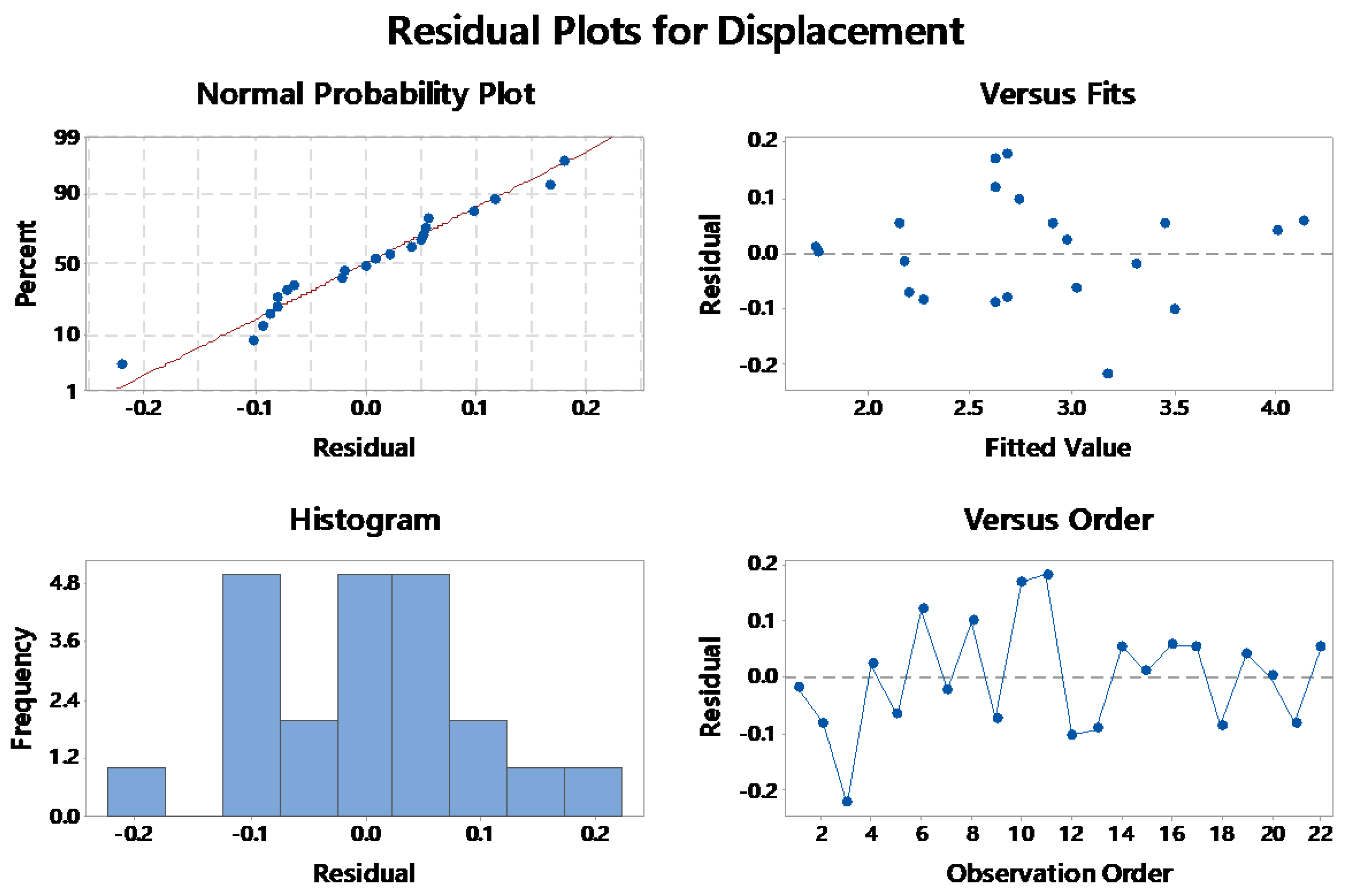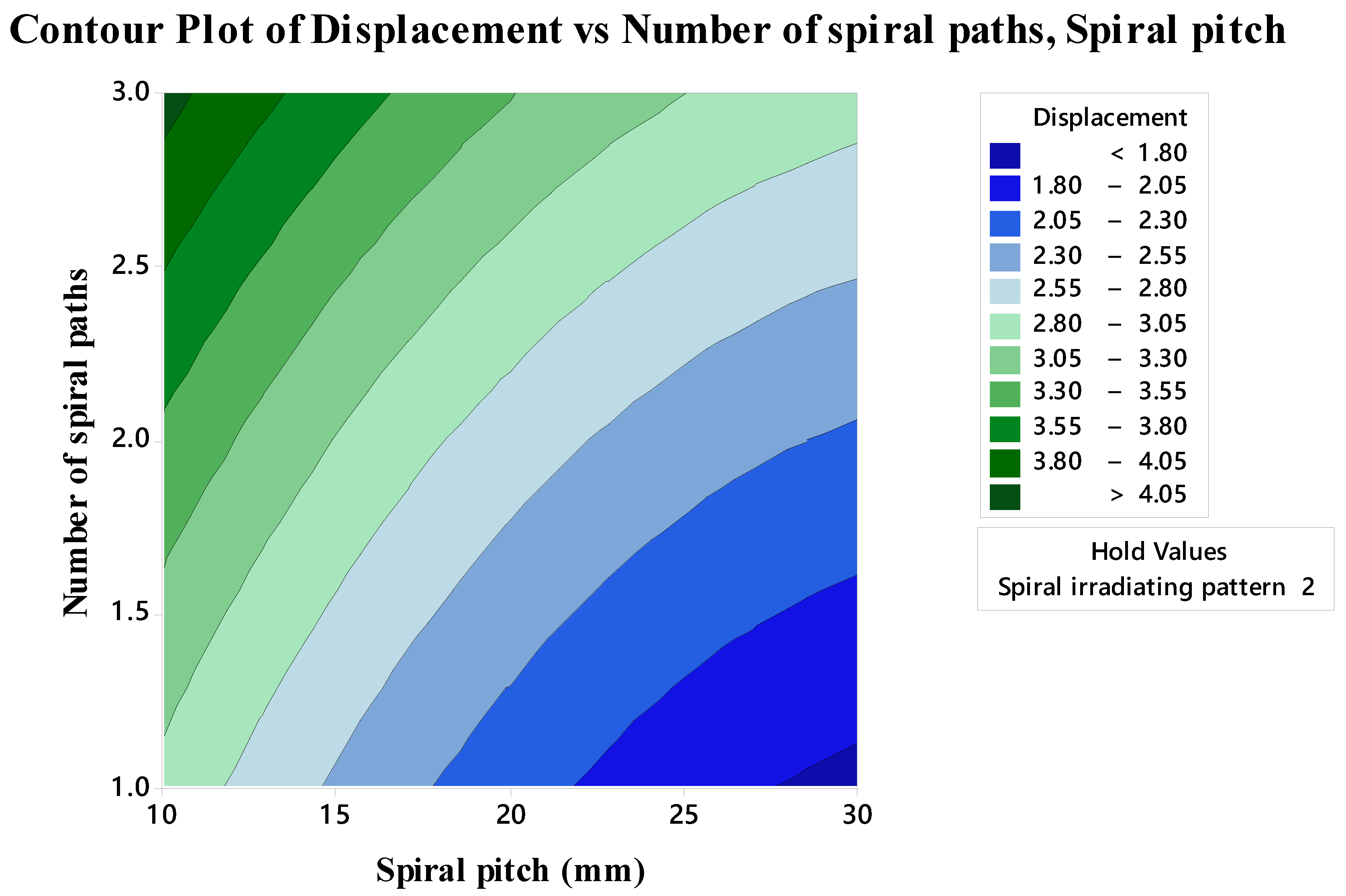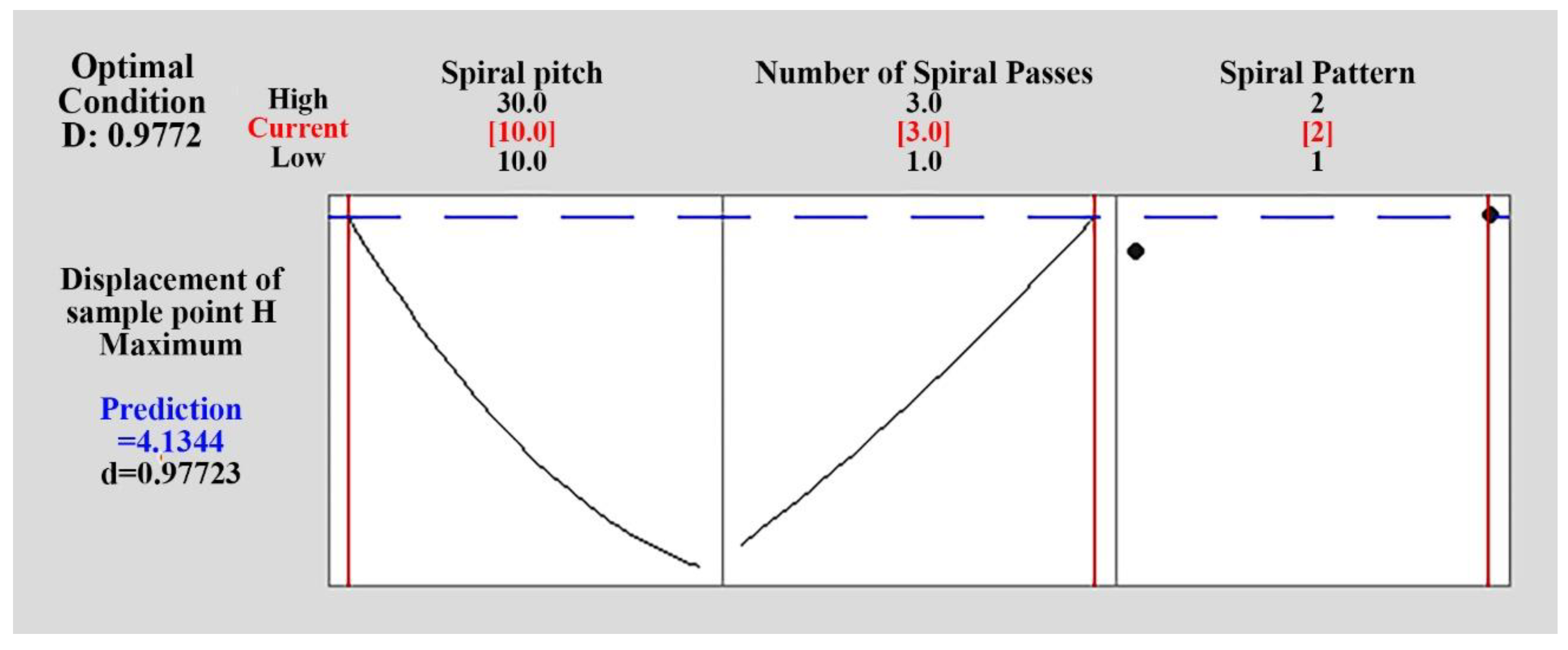Fabrication of Saddle-Shaped Surfaces by a Laser Forming Process: An Experimental and Statistical Investigation
Abstract
:1. Introduction
2. Materials and Methods
3. Results and Discussion
3.1. Analysis of Variance
3.2. Mean Effects of Manufacturing Parameters
3.3. Optimized Condition
4. Conclusions
Author Contributions
Funding
Conflicts of Interest
References
- Zhao, Y.; Hu, C.; Dong, H.; Yuan, H. Automated local line rolling forming and simplified deformation simulation method for complex curvature plate of ships. Mech. Sci. 2017, 8, 137–154. [Google Scholar] [CrossRef] [Green Version]
- Cheng, G.J.; Yao, Y.L. Process Design of Laser Forming for Three-Dimensional Thin Plates. J. Manuf. Sci. Eng. ASME 2004, 126, 217–225. [Google Scholar] [CrossRef]
- Jamil, S.; Sheikh, M.A.; Li, L. The effect of laser beam geometries on laser forming of sheet metal. In Proceedings of the 36th International MATADOR Conference, Mancheste, UK, 14 July 2010; Springer: London, UK, 2010; Volume 1, pp. 509–512. [Google Scholar]
- Das, B.; Biswas, P. A Review of Plate Forming by Line Heating. J. Ship Prod. Des. 2018, 34, 155–167. [Google Scholar] [CrossRef]
- Nowak, Z.; Nowak, M.; Widlaszewski, J.; Kurp, P. Experimental and numerical investigation on laser-assisted bending of pre-loaded metal plate. AIP Conf. Proc. 2018, 1922, 140006. [Google Scholar] [CrossRef]
- Safari, M.; Joudaki, J. Prediction of bending angle for laser forming of tailor machined blanks by neural network. Iran J. Mater. Form 2018, 1, 47–57. [Google Scholar]
- Keisuke, K.; Nakamura, T.; Aoyama, H.; Mastushita, N.; Ushimaru, A. Basic Study on Laser Forming Method for Curved Surfaces. Key Eng. Mater. 2012, 523, 995–1000. [Google Scholar] [CrossRef]
- Yu, G.; Patrikalakis, N.M.; Maekawa, T. Optimal development of doubly curved surfaces. Comput. Aided Geom. Des. 2000, 17, 545–577. [Google Scholar] [CrossRef] [Green Version]
- Chakraborty, S.S.; Racherla, V.; Nath, A.K. Thermo-mechanical finite element study on deformation mechanics during radial scan line laser forming of a bowl shaped surface out of a thin sheet. J. Manuf. Process. 2018, 31, 593–604. [Google Scholar] [CrossRef]
- Liu, C.; Yao, Y.L. FEM-Based Process Design for Laser Forming of Doubly Curved Shapes. J. Manuf. Process. 2005, 7, 109–121. [Google Scholar] [CrossRef]
- Na, S.; Kim, J.T. 3D laser forming strategies for sheet metal by geometrical information. Int. J. Mater. Form. 2008, 1, 1367–1370. [Google Scholar] [CrossRef]
- Kim, J.; Na, S. 3D laser-forming strategies for sheet metal by geometrical information. Opt. Laser Technol. 2009, 41, 843–852. [Google Scholar] [CrossRef]
- Gao, H.; Sheikholeslami, G.; Dearden, G.; Edwardson, S. Reverse Analysis of Scan Strategies for Controlled 3D Laser Forming of Sheet Metal. Procedia Eng. 2017, 183, 369–374. [Google Scholar] [CrossRef]
- Shahabad, S.I.; Naeini, H.M.; Roohi, A.H.; Soltanpour, M.; Tavakoli, A. Height prediction of dome-shaped products in laser forming process. Int. J. Adv. Manuf. Technol. 2017, 88, 2227–2236. [Google Scholar] [CrossRef]
- Shahabad, S.I.; Naeini, H.M.; Roohi, A.H.; Tavakoli, A.; Nasrollahzade, M. Experimental investigation of laser forming process to produce dome-shaped products. Int. J. Adv. Manuf. Technol. 2017, 90, 1051–1057. [Google Scholar] [CrossRef]
- Shen, H.; Zhou, W.; Wang, H. Laser forming of doubly curved plates using minimum energy principle and comprehensive strain control. Int. J. Mech. Sci. 2018, 145, 42–52. [Google Scholar] [CrossRef]
- Shen, H.; Wang, H.; Zhou, W. Process modelling in laser forming of doubly-curved sheets from cylinder shapes. J. Manuf. Process. 2018, 35, 373–381. [Google Scholar] [CrossRef]
- Dixit, U.S.; Joshi, S.N.; Kant, R. Laser forming systems: A review. Int. J. Mechatron. Manuf. Syst. 2015, 8, 160. [Google Scholar] [CrossRef]
- Wang, X.; Shi, Y.; Guo, Y.; Sun, R.; Li, X.; Zhou, X. Laser curve scanning forming process of laminated metal composite plate. Mater. Des. 2020, 191, 108614. [Google Scholar] [CrossRef]
- Gisario, A.; Barletta, M. Laser forming of glass laminate aluminium reinforced epoxy (GLARE): On the role of mechanical, physical and chemical interactions in the multi-layers material. Opt. Lasers Eng. 2018, 110, 364–376. [Google Scholar] [CrossRef]
- Maji, K.; Pratihar, D.K.; Nath, A. Laser forming of a dome shaped surface: Experimental investigations, statistical analysis and neural network modeling. Opt. Lasers Eng. 2014, 53, 31–42. [Google Scholar] [CrossRef]
- Safari, M.; Farzin, M. Experimental investigation of laser forming of a saddle shape with spiral irradiating scheme. Opt. Laser Technol. 2015, 66, 146–150. [Google Scholar] [CrossRef]
- Safari, M.; Mostaan, H. Experimental and numerical investigation of laser forming of cylindrical surfaces with arbitrary radius of curvature. Alex. Eng. J. 2016, 55, 1941–1949. [Google Scholar] [CrossRef] [Green Version]
- Douglas, C. Montgomery, Design and Analysis of Experiments, 8th ed.; John Wiley & Sons, Inc.: New York, NY, USA, 2012. [Google Scholar]





| Reference | Fabricated Shape | Irradiation Scheme | Material | Laser Power (Watts) | Blank Dimensions |
|---|---|---|---|---|---|
| Chakraborty et al. [9] | Bowl-shaped surface | Radial scan | AISI 304 stainless steel | 350 | ϕ100 mm, 1 mm thickness |
| Liu and Yao [10] | Pillow- and saddle-shaped surfaces | Calculated paths | 1010 mild steel | 1000 | 140 × 80 × 0.89 mm3 |
| Na and Kim [11] and Kim and Na [12] | Saddle-shaped surface | Calculated paths | mild steel | 100 | 30 × 30 × 0.8 mm3 |
| Gao et al. [13] | Ship hull shape | Calculated paths | S275 steel | 400 | 100 × 100 × 1.5 mm3 |
| Imani Shahabad et al. [14,15] | Dome-shaped surface | Spider scanning paths | AA 6061-T6 aluminium alloy | 2500 | ϕ150 mm, 2 mm thickness |
| Shen et al. [16,17] | Pillow, warped and saddle shape | Computational scanning path | 304 stainless steel | 200 | 100 × 100 × 2 mm3 100 × 100 × 1 mm3 |
| Maji et al. [21] | Dome-shaped surface | Cross (axial and diagonal) scanning paths | AISI 304 stainless steel | 400 | 60 × 60 × 1 mm3 90 × 90 × 1 mm3 120 × 120 × 1 mm3 |
| Component | Fe | C | Cu | Cr | Ni | Mn | Si | P | S |
|---|---|---|---|---|---|---|---|---|---|
| Weight (%) | Base | 0.194 | 0.261 | 0.103 | 0.155 | 0.673 | 0.183 | 0.046 | 0.057 |
| Sample | Spiral Pitch (mm) | Number of Spiral Passes | Spiral Pattern | Deformation of Sample Point H (mm) |
|---|---|---|---|---|
| 1 | 20 | 1 | 1 | 2.16 |
| 2 | 20 | 2 | 2 | 2.60 |
| 3 | 20 | 3 | 1 | 2.95 |
| 4 | 10 | 1 | 2 | 3.00 |
| 5 | 10 | 1 | 1 | 2.95 |
| 6 | 20 | 2 | 1 | 2.74 |
| 7 | 20 | 3 | 2 | 3.29 |
| 8 | 30 | 3 | 1 | 2.84 |
| 9 | 30 | 2 | 1 | 2.12 |
| 10 | 20 | 2 | 1 | 2.79 |
| 11 | 20 | 2 | 2 | 2.86 |
| 12 | 10 | 2 | 2 | 3.40 |
| 13 | 20 | 2 | 1 | 2.53 |
| 14 | 30 | 3 | 2 | 2.95 |
| 15 | 30 | 1 | 2 | 1.75 |
| 16 | 10 | 3 | 2 | 4.19 |
| 17 | 20 | 1 | 2 | 2.21 |
| 18 | 30 | 2 | 2 | 2.18 |
| 19 | 10 | 3 | 1 | 4.05 |
| 20 | 30 | 1 | 1 | 1.75 |
| 21 | 20 | 2 | 2 | 2.60 |
| 22 | 10 | 2 | 1 | 3.51 |
| Parameter | Symbol | Levels | |||
|---|---|---|---|---|---|
| Spiral pitch (mm) | S | 10 | 20 | 30 | |
| Number of spiral passes | N | 1 | 2 | 3 | |
| Spiral pattern | P | In-to-out (1) | Out-to-in (2) | ||
| Term | Coef. | SE Coef. | T-Value | P-Value |
|---|---|---|---|---|
| Constant | 2.6516 | 0.0446 | 59.44 | 0.000 |
| S | −0.6258 | 0.0355 | −17.63 | 0.000 |
| N | 0.5375 | 0.0355 | 15.14 | 0.000 |
| P | −0.0291 | 0.0262 | −1.11 | 0.287 |
| S × S | 0.2036 | 0.0546 | 3.73 | 0.003 |
| N × N | 0.0536 | 0.0546 | 0.98 | 0.345 |
| S × N | 0.0024 | 0.0435 | −0.03 | 0.643 |
| S × P | −0.0075 | 0.0355 | −0.21 | 0.836 |
| N × P | −0.0408 | 0.0355 | −1.15 | 0.271 |
| Source | DF | Adj SS | Adj MS | F-Value | P-Value | Significance |
|---|---|---|---|---|---|---|
| Regression | 8 | 8.47954 | 1.05994 | 70.09 | 0.000 | OK |
| Linear | 3 | 8.18550 | 2.72850 | 180.43 | 0.000 | OK |
| Square | 2 | 0.27336 | 0.13668 | 9.04 | 0.003 | OK |
| Interaction | 3 | 0.02068 | 0.00689 | 0.46 | 0.718 | Not-OK |
| R2 = 97.73% | ||||||
| Pred R2 = 94.33% | ||||||
| Adj R2 = 96.34% |
© 2020 by the authors. Licensee MDPI, Basel, Switzerland. This article is an open access article distributed under the terms and conditions of the Creative Commons Attribution (CC BY) license (http://creativecommons.org/licenses/by/4.0/).
Share and Cite
Safari, M.; Alves de Sousa, R.; Joudaki, J. Fabrication of Saddle-Shaped Surfaces by a Laser Forming Process: An Experimental and Statistical Investigation. Metals 2020, 10, 883. https://doi.org/10.3390/met10070883
Safari M, Alves de Sousa R, Joudaki J. Fabrication of Saddle-Shaped Surfaces by a Laser Forming Process: An Experimental and Statistical Investigation. Metals. 2020; 10(7):883. https://doi.org/10.3390/met10070883
Chicago/Turabian StyleSafari, Mehdi, Ricardo Alves de Sousa, and Jalal Joudaki. 2020. "Fabrication of Saddle-Shaped Surfaces by a Laser Forming Process: An Experimental and Statistical Investigation" Metals 10, no. 7: 883. https://doi.org/10.3390/met10070883







